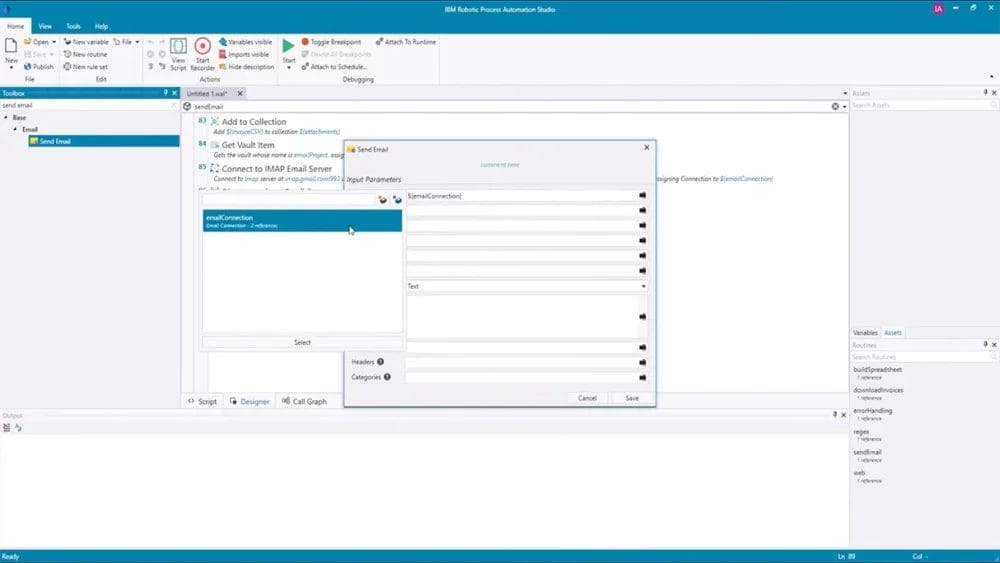What Are the Benefits of RPA for a Business?
The benefits of RPA for business process automation seems impressive. Still, for those still on the fence, here are some benefits worth considering

Robotic process automation (RPA) is a technical concept of teaching a machine to mimic the activity of a human being. While it’s not as independent and broad as AI, it can become almost as accurate within this limited scope of tasks. Now, given the fact that it’s a machine, it can do the following tasks:
- More quickly (instantaneously)
- More accurately (there’s no room for human error)
- Regardless of how boring they are
All of these make a massive difference in operational efficiency. To put things into simpler terms, it allows you to do more with less. Some posts and tasks are more boring than others, leading to high employee attrition. After a while, the productivity plummets, but this won’t last for too long.
With all of this in mind, the benefits of RPA seem impressive. Still, some benefits of robotic process automation are worth considering for those still on the fence.
Get the Best Updates on SaaS, Tech, and AI
1. Save Business Costs by Being Efficient

Increased productivity is essential for many reasons, so people don’t waste too much time on mundane tasks. Using RPA tools with the people you already have on staff saves money. Consider using robots in a department like accounts payable or receivable, where employees often have to move data from different portals into your company’s systems. Robots could be helpful in a department like this one.
The ability of robotic process automation to cut down on mistakes and shorten processing times means that processing costs go down while per-worker output goes up. These different ways to make things more efficient are expected to save between 25 and 50 percent of costs.
2. Data Entry Accuracy Greatly Benefits from Robotic Process Automation

With RPA, the robotic process will handle the task you have programmed it to and in the way you programmed it to. So, will that make a mistake? Well, the programming could have been done better. On a more straightforward task, the accuracy of this technology is 99.9%, seeing as there’s not much that you can do wrong. Compared to data entry mistakes made by human employees, these numbers will seem even more impressive.
In some scenarios, however, the RPA is only partially responsible for the accuracy. You see, it all depends on the form of data. With structured data (the one in written, intelligible form like the one that comes in tables), the accuracy is almost 100%. However, with unstructured data, the system may depend on imperfect technologies like OCR (optical character recognition) or voice recognition. The RPA solution is as accurate as the recognition tool in this scenario. The problem is that some people might not make the connection between the two and automatically accuse the RPA as a direct software used.
3. Increased Business Productivity

The main reason why RPA is used is the increase in productivity. This comes in many forms like reduction of data errors, higher quality data, removal of overload, and preservation of work elan of your staff.
Besides this, the RPA ROI is impressive and easy to measure. You take the number of hours an average employee would take to complete a particular task, and then you compare this cumulative wage to the software license cost. Now, keep in mind that this is the crudest comparison possible. Why? Because it’s not taking into account the accuracy of data and similar concepts.
It also needs to consider that an average employee will eventually get bored doing these repetitive tasks. This leads to an increased employee abandonment rate, which you’ll have to handle by bringing in new employees. The hiring process, training process, and onboarding are all quite expensive, and skipping them leads to a higher ROI.
Additionally, RPA always performs the same. For an employee, the first hour of the workday is less productive than the last. As they get tired, their concentration falls off, and they eventually become more likely to make mistakes. Here, the RPA offers the kind of consistency your business needs.
4. Faster Implementation is a Larger Part of RPA Benefits
Saying that an RPA is faster to implement is a controversial statement for a single reason – because people often underestimate just how much time and effort it takes to train a newly hired person. Keep in mind that it may take a bit for your IT staff to fully grasp what’s going on or become completely efficient at RPA maintenance. Still, there are not a lot of companies handling RPA IT management in-house, and it’s far more likely that you’ll outsource this, too.
Another misconception lies in comparing RPA to AI integration. You must understand that while most AI contains all sorts of RPA processes, your RPA doesn’t have to be AI-driven.
Also, RPA can be applied to every single software. After all, RPA is designed to mimic human actions. Any software your team currently uses can be shifted to RPA. This makes RPA quite versatile and applicable to any business model. As for the implementation, it depends on the complexity of the platform on the action. Still, even in the most pessimistic of scenarios, it doesn’t make that much difference.
5. Great Scalability

The fact that RPA is easily scalable is more than self-evident. Once your workload increases, all you need to do is add an extra bot, and that’s it. In every way conceivable, it’s easier than hiring a new person. However, chances are that if your workload increases, you’ll have to bring in more than one new employee.
Also, you’re not limited to a single bot, and there’s no rule stating that you must keep the bot past the point where you no longer need it.
Once you feel the need to get a new bot, all you should do is contact your software provider. You do the same thing if you no longer need them.
It’s also worth mentioning that the implementation dramatically depends on the type of task that you’re trying to implement. For instance:
- Rule-based tasks
- Labor-intensive tasks
- Tasks with structured (readable) data
These three are the easiest to implement. Therefore, switching to RPA is the best course of action if this is your primary workload. Also, the sooner you change, the higher the RPA and the more you get to save.
Some people love to compare RPA integration to managing a remote team. While handling RPA can be even more straightforward, the truth is that these two concepts are not mutually exclusive. A remote team will only be more effective with RPA, and since both of these solutions are scalable, they work great in unison (even in the long run).
6. No Downtime
Automated software can work 24/7. The software services don’t take days off, don’t go on sick leave, and, most importantly, never quit. This means you get more work hours from even the most straightforward RPA systems than you would from even the most devoted employee.
Now, if you decide to measure your workforce against this type of platform, you would have to measure either working hours, the amount of work done, or, even better, the amount of work done per hour. It is the only way to make an adequate evaluation of whether you’re getting your money’s worth from this investment.
Keep in mind that downtime has several layers to it. First, downtime is more than just a loss of working hours, and it’s also a potential loss of clients. A client who wants to contact you but can’t is bound to go someplace else. A task that’s not resolved right away will sometimes require a solution from a different source.
Speaking about workforce and downtime, it’s also important to mention that an RPA is operational and efficient from the moment you start using it. There’s no training time and no such thing as time to become efficient.
7. Minimal IT Resources and Better Cybersecurity

While this may sound a bit controversial, you must take a look at the big picture. Sure, running an RPA requires some IT support. However, it’s a lot easier than keeping track of several different accounts and resolving issues of numerous employees. When you compare the number of experts in charge of the RPA and how much support you would need to handle an equivalent number of employees, the numbers get pretty heavily in favor of automation.
Another Massive Benefit of the RPA is that data encryption in RPA provides better IT security with fewer resources. A security incident is discovered much more quickly if you use an RPA. Now, keep in mind that in cybersecurity, discovery time makes all the difference in the world.
RPA decreases human error and lowers cybersecurity threats from sources like phishing. As we’ve mentioned earlier, with RPA, fewer people will be logging in, which means fewer potential loopholes. If anything, you can assign privileges and create role-based authentication, which is vast in managing who has access to sensitive data.
Most importantly, a sophisticated tool such as RPA ensures that the version that you’re using is constantly up to date. In many enterprises, companies use legacy platforms to streamline processes and simplify things for their employees (who have already passed the training). With RPA, this will no longer be the case.
8. Local Economy and Repatriation of Jobs
One of the biggest concerns about the RPA is how it will affect the local economy once employers need less workforce. The truth is that these data-entry jobs are usually outsourced to areas with a significantly lower purchasing power parity. If anything, increasing RPA demands will increase the number of technicians needed and, for the most part, increase one’s reliance on local partnerships. Contrary to popular belief, increased support for RPA may even lead to a higher rate of repatriation of jobs.
9. Make the Customer Experience Better

Artificial intelligence (AI) powered natural language processing is only one example of RPA gaining traction in the customer service industry. The main advantages in this field now, however, come from a decrease in the number of time workers spend on routine chores.
Providing excellent customer service is time- and energy-intensive for all staff members. Employees can focus once again on satisfying customers’ needs with less time spent on routine administrative duties. Time spent on the resolution will decrease, the number of complaints filed will go down, and overall customer satisfaction will go up.
10. Automate Sales and Marketing
The number of records that are generated by the sales staff is astonishing. A well-configured RPA system can assist in the unification of sales data, which may seem impossible, given how much data there is. RPA is also capable of adhering to rules about the evaluation and assignment of leads, ensuring always qualified leads are available to the employees who should be working with them.
The marketing team can construct more comprehensive client profiles due to the RPA unification, which provides increased visibility into sales data. These data could lead to developing marketing initiatives that are more successful at convincing the target audience.
11. Data Management & Analytics

Because businesses deal with a lot of information, employees must do a lot of time-consuming and mundane tasks to manage that information. These workflows are very well suited to being automated.
RPA systems can be “taught” to do simple tasks like data validation (checking to see if data fits within expected parameters) and data cleaning with little effort (removing invalid entries). In the meantime, RPA helps with getting data into the system. Tools with optical character recognition can sort documents into the right places or move information from documents to recording software in a reliable way. OCR stands for optical character recognition (OCR).
Because you just got new robots, you don’t know what you don’t know. At least, you won’t until you gather detailed information about how well your processes are running. RPA helps find places in a process that need improvement, which helps find process gaps. These gaps show that there aren’t enough people or software resources, and they often show that automation needs to be more innovative and more complex than what essential RPA software can do.
12. Human Resources & Employee Engagement

The use of RPA is beneficial in a variety of HR contexts. In a survey conducted by the Process Excellence Network, only 29% of respondents identified human resources as a target area for deploying RPA; however, new use cases will drive that number higher in the future. The following are some of the most common applications used today:
- Keeping better track of employee records and ensuring they are always up to date
- Streamlining the procedures for onboarding newly hired employees
- Unifying the data on employees that are stored in the various HR computer systems
The Most Common Use Cases in Which Businesses Can Make Use of RPA
- Entry of data that is automated in more advanced ERP systems
- Performing operations to either upload or download documents
- Completing fields on a screen-based form
- Checking the differences between the data fields on the screen
- Integration of ERP with various legacy systems as well as third-party apps
- Automating data migration Screen scraping data on screen
- recognizing a deviation from a procedure and marking it so that it can be reviewed later
- Data mining
- Maintaining vigilance over the transmission of email
- Sales Orders Processing
- Processing of the Payroll Management System Information Regarding HR
Is RPA or Robotic Automation suitable for the future?
There is no doubt that RPA is suitable for the future. RPA can automate repetitive tasks, improve accuracy and efficiency, and help organizations keep up with the ever-changing digital landscape. With the help of RPA, businesses can scale their operations without adding more employees. This makes RPA an attractive option for companies looking to improve their bottom line. In addition, RPA can help organizations become more agile and responsive to change. As the world continues to digitize, RPA will only become more valuable.
Well-known RPA Solution and RPA Robot Software

Here we have a short but well-known list of RPA software or RPA bots that can put assistive automation in your business processes.
- IBM Robotic Process Automation
- Microsoft Power Automate
- Automation Anywhere – RPA | Robotic Process Automation
- Appian
- Robocorp
- SS&C Blue Prism – RPA | Robotic Process Automation
- Aiwozo
- UiPath Business Automation Platform
- akaBot
- WinAutomation by Softomotive
Wrap-Up – Benefits of RPA in Business
The benefits of RPA are too numerous to mention in a single list. Still, by now, you’re supposed to have a clear idea of some of the benefits of the RPA. As for the downsides, the critical thing is that RPA is a method (a tool), and it’s how you use it and what you use it for that matters.
Can it be used inefficiently? Yes! Can it lose you more money than saving? Yes. We’re assuming you’ve planned this through and done your math. There are a few things to worry about.
FTC Disclosure: The pages you visit may have external affiliate links that may result in me getting a commission if you decide to buy the mentioned product. It gives a little encouragement to a smaller content creator like myself.


